Comprehensive Evaluation of Health History and Medical Information
VerifiedAdded on 2022/08/16
|5
|1034
|14
Report
AI Summary
This report provides a critical evaluation of Mr. C's health condition, based on the provided case study. Mr. C, a 32-year-old, is obese and considering bariatric surgery. The report analyzes his clinical manifestations, including a BMI of 44.9, hypertension, dyspnea, diabetes, and elevated cholesterol, creatinine, and BUN levels. It identifies potential health risks such as heart problems and renal failure, emphasizing the need for interventions. The report discusses the staging of end-stage renal disease (ESRD) and contributing factors. It also explores ESRD prevention strategies, the importance of diet and lifestyle changes, and the benefits of a multidisciplinary approach involving physicians, nutritionists, nurses, and physical trainers. The conclusion summarizes Mr. C's conditions and the importance of preventive measures to avoid ESRD.
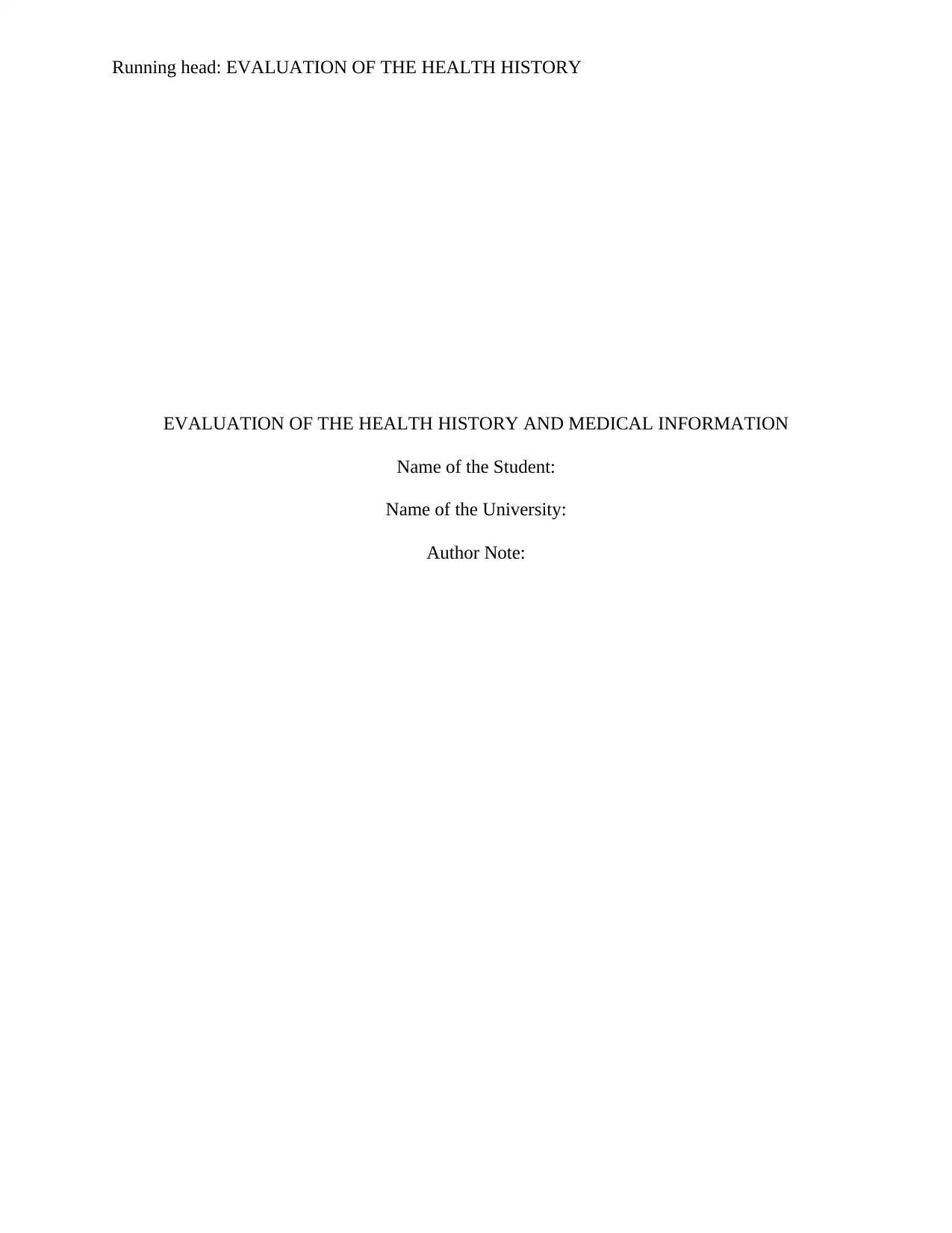
Running head: EVALUATION OF THE HEALTH HISTORY
EVALUATION OF THE HEALTH HISTORY AND MEDICAL INFORMATION
Name of the Student:
Name of the University:
Author Note:
EVALUATION OF THE HEALTH HISTORY AND MEDICAL INFORMATION
Name of the Student:
Name of the University:
Author Note:
Paraphrase This Document
Need a fresh take? Get an instant paraphrase of this document with our AI Paraphraser
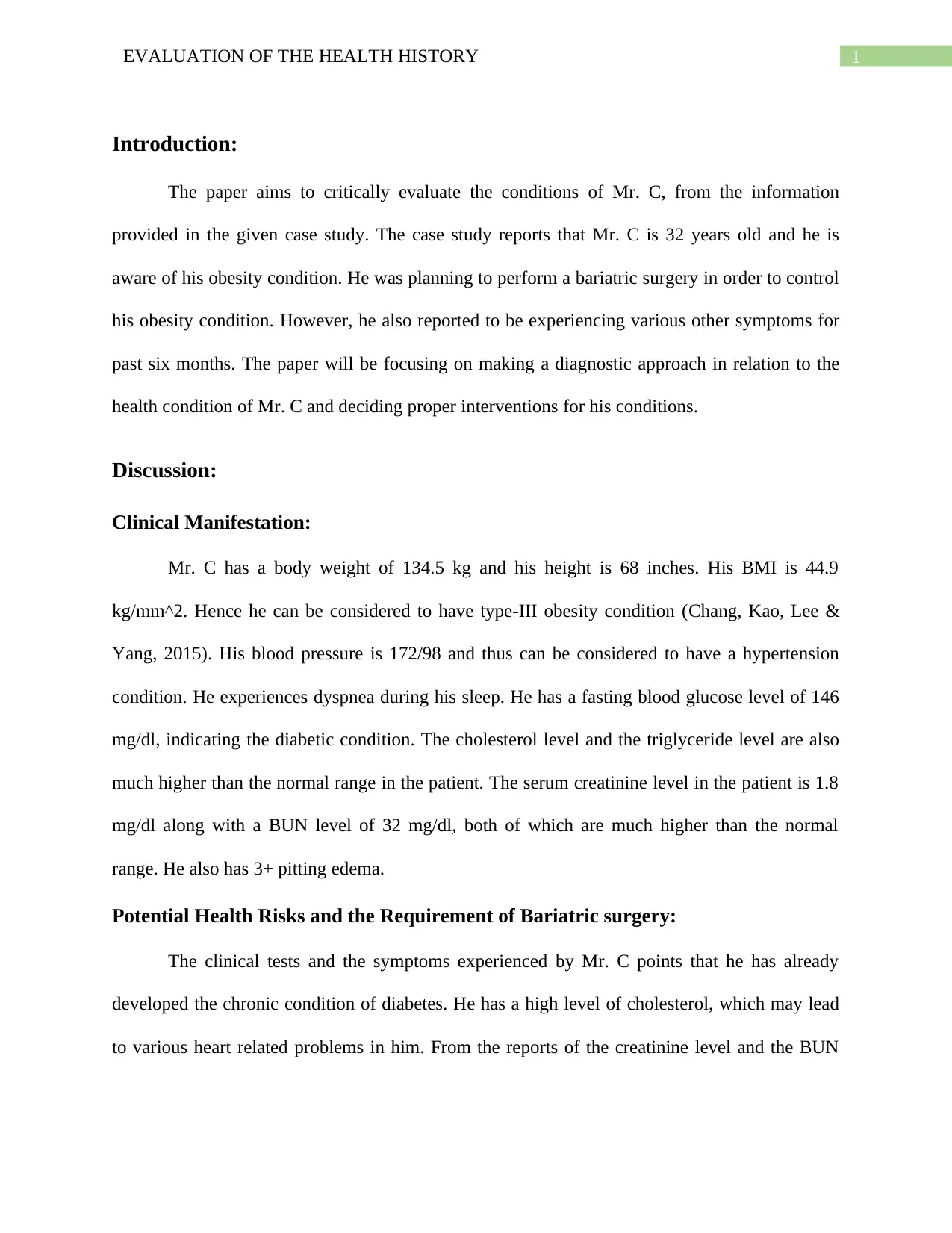
1EVALUATION OF THE HEALTH HISTORY
Introduction:
The paper aims to critically evaluate the conditions of Mr. C, from the information
provided in the given case study. The case study reports that Mr. C is 32 years old and he is
aware of his obesity condition. He was planning to perform a bariatric surgery in order to control
his obesity condition. However, he also reported to be experiencing various other symptoms for
past six months. The paper will be focusing on making a diagnostic approach in relation to the
health condition of Mr. C and deciding proper interventions for his conditions.
Discussion:
Clinical Manifestation:
Mr. C has a body weight of 134.5 kg and his height is 68 inches. His BMI is 44.9
kg/mm^2. Hence he can be considered to have type-III obesity condition (Chang, Kao, Lee &
Yang, 2015). His blood pressure is 172/98 and thus can be considered to have a hypertension
condition. He experiences dyspnea during his sleep. He has a fasting blood glucose level of 146
mg/dl, indicating the diabetic condition. The cholesterol level and the triglyceride level are also
much higher than the normal range in the patient. The serum creatinine level in the patient is 1.8
mg/dl along with a BUN level of 32 mg/dl, both of which are much higher than the normal
range. He also has 3+ pitting edema.
Potential Health Risks and the Requirement of Bariatric surgery:
The clinical tests and the symptoms experienced by Mr. C points that he has already
developed the chronic condition of diabetes. He has a high level of cholesterol, which may lead
to various heart related problems in him. From the reports of the creatinine level and the BUN
Introduction:
The paper aims to critically evaluate the conditions of Mr. C, from the information
provided in the given case study. The case study reports that Mr. C is 32 years old and he is
aware of his obesity condition. He was planning to perform a bariatric surgery in order to control
his obesity condition. However, he also reported to be experiencing various other symptoms for
past six months. The paper will be focusing on making a diagnostic approach in relation to the
health condition of Mr. C and deciding proper interventions for his conditions.
Discussion:
Clinical Manifestation:
Mr. C has a body weight of 134.5 kg and his height is 68 inches. His BMI is 44.9
kg/mm^2. Hence he can be considered to have type-III obesity condition (Chang, Kao, Lee &
Yang, 2015). His blood pressure is 172/98 and thus can be considered to have a hypertension
condition. He experiences dyspnea during his sleep. He has a fasting blood glucose level of 146
mg/dl, indicating the diabetic condition. The cholesterol level and the triglyceride level are also
much higher than the normal range in the patient. The serum creatinine level in the patient is 1.8
mg/dl along with a BUN level of 32 mg/dl, both of which are much higher than the normal
range. He also has 3+ pitting edema.
Potential Health Risks and the Requirement of Bariatric surgery:
The clinical tests and the symptoms experienced by Mr. C points that he has already
developed the chronic condition of diabetes. He has a high level of cholesterol, which may lead
to various heart related problems in him. From the reports of the creatinine level and the BUN
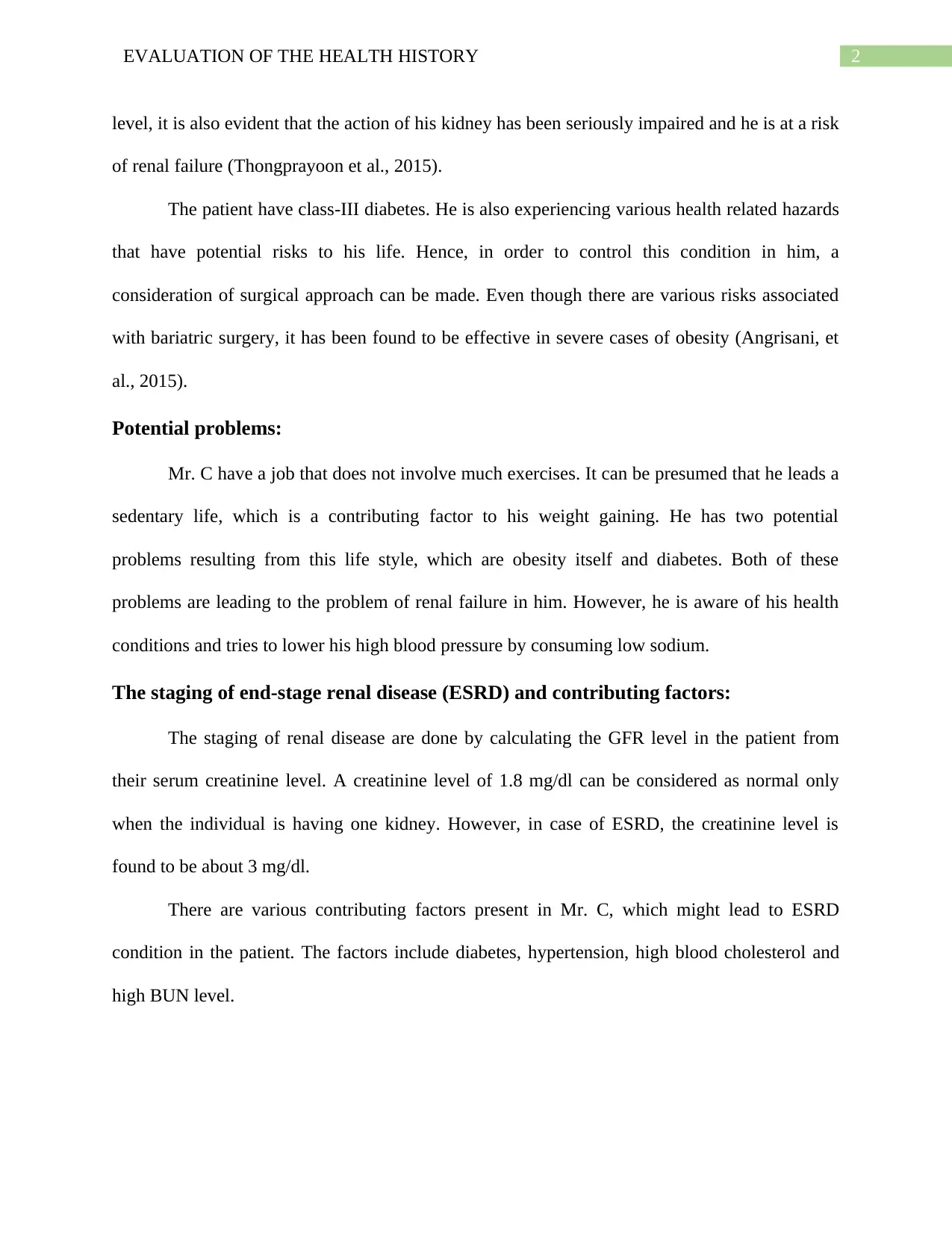
2EVALUATION OF THE HEALTH HISTORY
level, it is also evident that the action of his kidney has been seriously impaired and he is at a risk
of renal failure (Thongprayoon et al., 2015).
The patient have class-III diabetes. He is also experiencing various health related hazards
that have potential risks to his life. Hence, in order to control this condition in him, a
consideration of surgical approach can be made. Even though there are various risks associated
with bariatric surgery, it has been found to be effective in severe cases of obesity (Angrisani, et
al., 2015).
Potential problems:
Mr. C have a job that does not involve much exercises. It can be presumed that he leads a
sedentary life, which is a contributing factor to his weight gaining. He has two potential
problems resulting from this life style, which are obesity itself and diabetes. Both of these
problems are leading to the problem of renal failure in him. However, he is aware of his health
conditions and tries to lower his high blood pressure by consuming low sodium.
The staging of end-stage renal disease (ESRD) and contributing factors:
The staging of renal disease are done by calculating the GFR level in the patient from
their serum creatinine level. A creatinine level of 1.8 mg/dl can be considered as normal only
when the individual is having one kidney. However, in case of ESRD, the creatinine level is
found to be about 3 mg/dl.
There are various contributing factors present in Mr. C, which might lead to ESRD
condition in the patient. The factors include diabetes, hypertension, high blood cholesterol and
high BUN level.
level, it is also evident that the action of his kidney has been seriously impaired and he is at a risk
of renal failure (Thongprayoon et al., 2015).
The patient have class-III diabetes. He is also experiencing various health related hazards
that have potential risks to his life. Hence, in order to control this condition in him, a
consideration of surgical approach can be made. Even though there are various risks associated
with bariatric surgery, it has been found to be effective in severe cases of obesity (Angrisani, et
al., 2015).
Potential problems:
Mr. C have a job that does not involve much exercises. It can be presumed that he leads a
sedentary life, which is a contributing factor to his weight gaining. He has two potential
problems resulting from this life style, which are obesity itself and diabetes. Both of these
problems are leading to the problem of renal failure in him. However, he is aware of his health
conditions and tries to lower his high blood pressure by consuming low sodium.
The staging of end-stage renal disease (ESRD) and contributing factors:
The staging of renal disease are done by calculating the GFR level in the patient from
their serum creatinine level. A creatinine level of 1.8 mg/dl can be considered as normal only
when the individual is having one kidney. However, in case of ESRD, the creatinine level is
found to be about 3 mg/dl.
There are various contributing factors present in Mr. C, which might lead to ESRD
condition in the patient. The factors include diabetes, hypertension, high blood cholesterol and
high BUN level.
⊘ This is a preview!⊘
Do you want full access?
Subscribe today to unlock all pages.

Trusted by 1+ million students worldwide
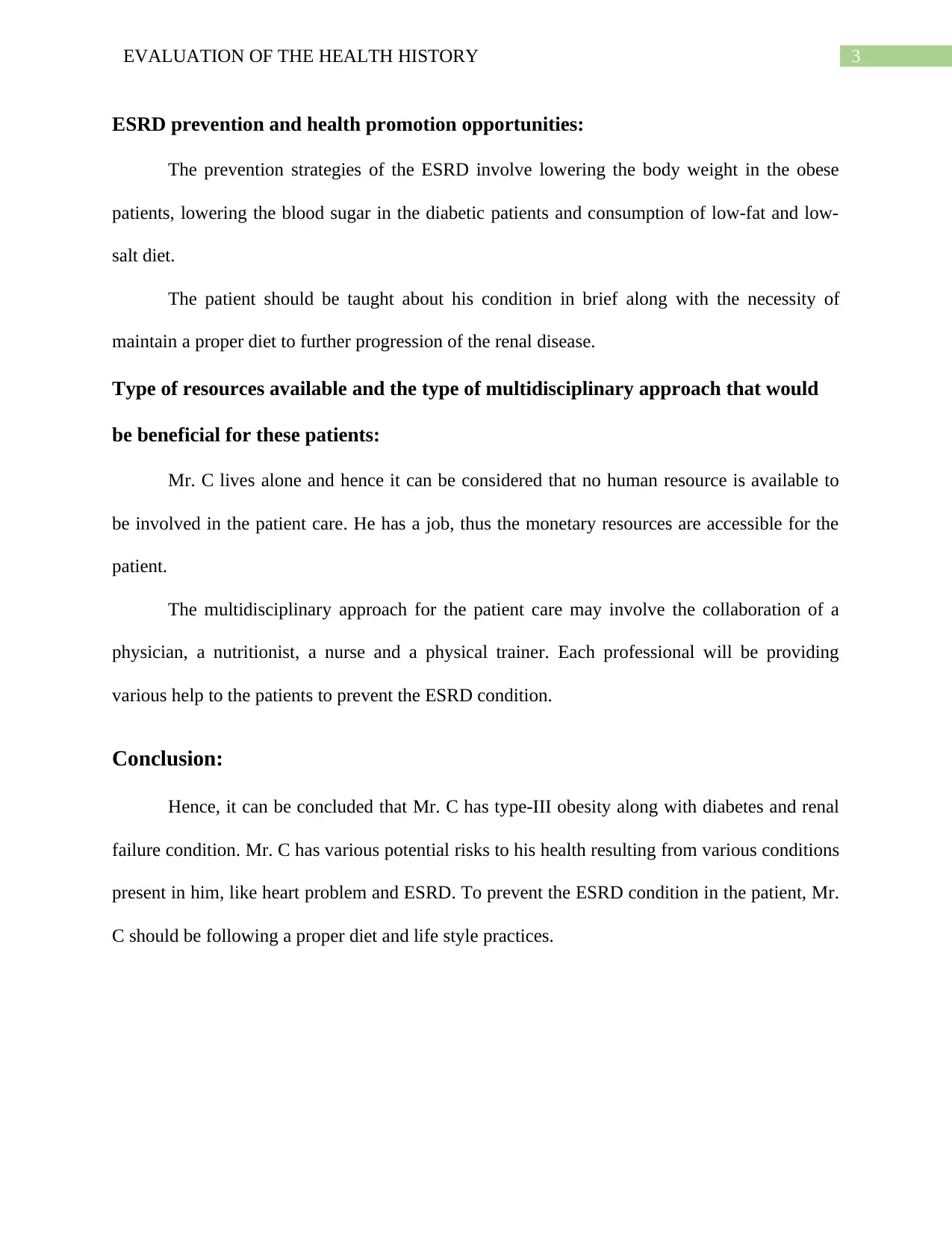
3EVALUATION OF THE HEALTH HISTORY
ESRD prevention and health promotion opportunities:
The prevention strategies of the ESRD involve lowering the body weight in the obese
patients, lowering the blood sugar in the diabetic patients and consumption of low-fat and low-
salt diet.
The patient should be taught about his condition in brief along with the necessity of
maintain a proper diet to further progression of the renal disease.
Type of resources available and the type of multidisciplinary approach that would
be beneficial for these patients:
Mr. C lives alone and hence it can be considered that no human resource is available to
be involved in the patient care. He has a job, thus the monetary resources are accessible for the
patient.
The multidisciplinary approach for the patient care may involve the collaboration of a
physician, a nutritionist, a nurse and a physical trainer. Each professional will be providing
various help to the patients to prevent the ESRD condition.
Conclusion:
Hence, it can be concluded that Mr. C has type-III obesity along with diabetes and renal
failure condition. Mr. C has various potential risks to his health resulting from various conditions
present in him, like heart problem and ESRD. To prevent the ESRD condition in the patient, Mr.
C should be following a proper diet and life style practices.
ESRD prevention and health promotion opportunities:
The prevention strategies of the ESRD involve lowering the body weight in the obese
patients, lowering the blood sugar in the diabetic patients and consumption of low-fat and low-
salt diet.
The patient should be taught about his condition in brief along with the necessity of
maintain a proper diet to further progression of the renal disease.
Type of resources available and the type of multidisciplinary approach that would
be beneficial for these patients:
Mr. C lives alone and hence it can be considered that no human resource is available to
be involved in the patient care. He has a job, thus the monetary resources are accessible for the
patient.
The multidisciplinary approach for the patient care may involve the collaboration of a
physician, a nutritionist, a nurse and a physical trainer. Each professional will be providing
various help to the patients to prevent the ESRD condition.
Conclusion:
Hence, it can be concluded that Mr. C has type-III obesity along with diabetes and renal
failure condition. Mr. C has various potential risks to his health resulting from various conditions
present in him, like heart problem and ESRD. To prevent the ESRD condition in the patient, Mr.
C should be following a proper diet and life style practices.
Paraphrase This Document
Need a fresh take? Get an instant paraphrase of this document with our AI Paraphraser
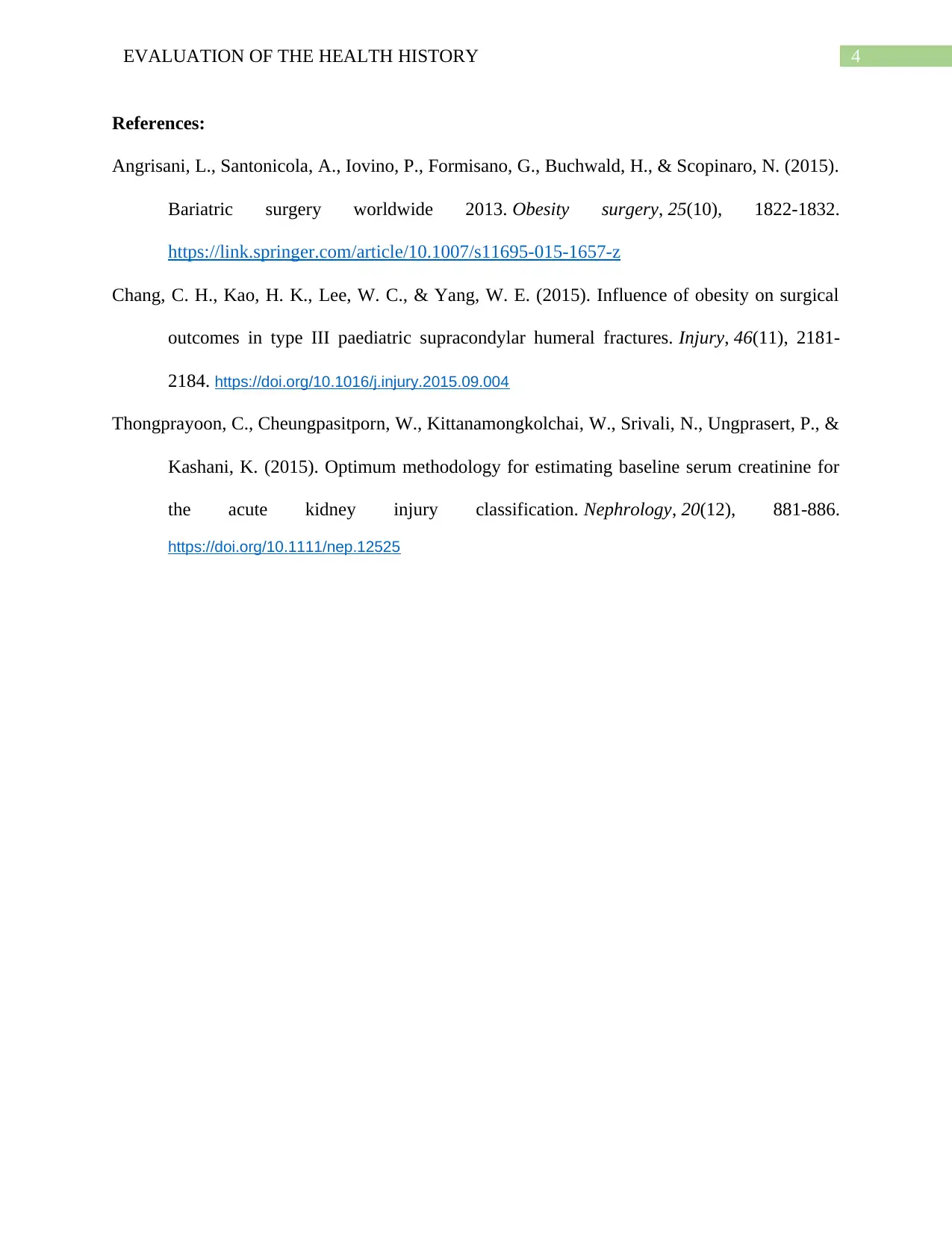
4EVALUATION OF THE HEALTH HISTORY
References:
Angrisani, L., Santonicola, A., Iovino, P., Formisano, G., Buchwald, H., & Scopinaro, N. (2015).
Bariatric surgery worldwide 2013. Obesity surgery, 25(10), 1822-1832.
https://link.springer.com/article/10.1007/s11695-015-1657-z
Chang, C. H., Kao, H. K., Lee, W. C., & Yang, W. E. (2015). Influence of obesity on surgical
outcomes in type III paediatric supracondylar humeral fractures. Injury, 46(11), 2181-
2184. https://doi.org/10.1016/j.injury.2015.09.004
Thongprayoon, C., Cheungpasitporn, W., Kittanamongkolchai, W., Srivali, N., Ungprasert, P., &
Kashani, K. (2015). Optimum methodology for estimating baseline serum creatinine for
the acute kidney injury classification. Nephrology, 20(12), 881-886.
https://doi.org/10.1111/nep.12525
References:
Angrisani, L., Santonicola, A., Iovino, P., Formisano, G., Buchwald, H., & Scopinaro, N. (2015).
Bariatric surgery worldwide 2013. Obesity surgery, 25(10), 1822-1832.
https://link.springer.com/article/10.1007/s11695-015-1657-z
Chang, C. H., Kao, H. K., Lee, W. C., & Yang, W. E. (2015). Influence of obesity on surgical
outcomes in type III paediatric supracondylar humeral fractures. Injury, 46(11), 2181-
2184. https://doi.org/10.1016/j.injury.2015.09.004
Thongprayoon, C., Cheungpasitporn, W., Kittanamongkolchai, W., Srivali, N., Ungprasert, P., &
Kashani, K. (2015). Optimum methodology for estimating baseline serum creatinine for
the acute kidney injury classification. Nephrology, 20(12), 881-886.
https://doi.org/10.1111/nep.12525
1 out of 5
Related Documents
Your All-in-One AI-Powered Toolkit for Academic Success.
+13062052269
info@desklib.com
Available 24*7 on WhatsApp / Email
![[object Object]](/_next/static/media/star-bottom.7253800d.svg)
Unlock your academic potential
Copyright © 2020–2025 A2Z Services. All Rights Reserved. Developed and managed by ZUCOL.





